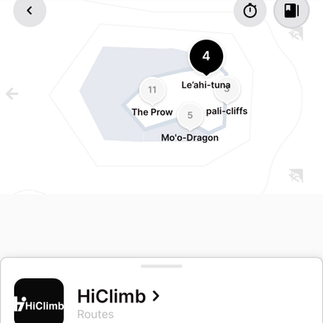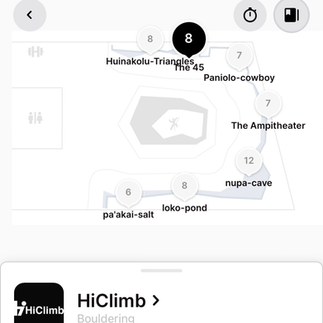Would you like some Paʻakai with your chalk?
- kanakaclimbers
- Feb 15, 2022
- 7 min read
Updated: Jul 13, 2022
Written by: Kānaka Climbers

In honor of the grand opening of Oʻahuʻs newest climbing gym, we want to acknowledge the cultural history of the space that HiClimb occupies. We think it is important to acknowledge that spaces are imbued with mana and significance even if they no longer resemble their traditional form. Without acknowledging the history of a space we can’t love it properly.
Looking around Kaka‘ako today and standing upon multiple feet of fill material deposited at the turn of the twentieth century, it may be hard to believe that as recently as 4,500 to 2,000 years ago the area was engulfed by the Pacific Ocean. As the sea level subsided, it left behind rows of sand dunes extending as far mauka as Queen St. The sand dunes predominantly ran perpendicular to the modern shoreline and between them formed brackish water wetlands, or salt marshes, where water collected from streams up mauka, tidal fluctuations and ground water, and local fresh water springs. It is important to know the history of this landscape because it contextualizes the millennia of interactions between humans and the environment that bring us to Kaka‘ako as we know it today.
The place name Kaka‘ako previously referred to a small ‘ili (subdivision of land) encompassing a section of land near Fort Armstrong or the modern One Waterfront Plaza between South and Punchbowl Streets. It is unknown exactly why the name Kakaʻako eventually became used to refer to the larger area we know today, and the place name Kakaʻako has multiple interpretations. One interpretation comes from the word “kākāʻāko”, meaning “dull and slow” (Pukui and Elbert 1986), which might refer to the slowly moving waters that covered much the landscape. Another comes from “kākā,” meaning “to chop, beat, or thresh,” and “ako,” meaning “thatch” (Thrum 1922). This possibly refers to the pili grass that grew in the salt marshes, which Kānaka Maoli traditionally used to thatch their homes and structures. The area we modernly know as Kaka‘ako is made up of multiple ‘ili named Kaʻākaukukui, Kukuluāeʻo, and Kewalo. These ʻili are part of the greater ahupuaʻa (traditional land division) of Honolulu (or Kou), within the moku (district) of Kona. HiClimb resides near the boundary of the ʻili of Kukuluāeʻo and Kewalo. It’s difficult to tell which ‘ili HiClimb is within based on available maps and documentation. Kukuluāeʻo means “to walk on stilts,” in reference to the Hawaiian stilt bird the Aeʻo, who would have been well suited for the former salt marshes of Kakaʻako. Kewalo means “the calling,” as in an echo.
Hawaiian stilt bird the Aeʻo -@birds_hawaii_pastpresent
Kakaʻako and its ʻili are mentioned in many moʻolelo and mythological accounts of traditional Hawaiʻi. ʻAiʻai, son of Kūʻula the fish god (cite, learn more), is said to have spent time in Kakaʻako after leaving his home of Maui to spread the word of Kūʻula and to establish koʻa kūʻula (fishing shrines) and koʻa ia (fishing stations where certain fish were known to gather) throughout the islands. Kewalo ʻili is well known to have been home to a famous fishpond called Kawailumalumai, translated as “drowning waters” (Sterling and Summers 1978), that was used to drown kapu breakers as part of a human sacrificial ritual known as Kānāwai Kaiheheʻe (Kamakau 1991). Human sacrifices were then taken to Kanelaau Heiau on the slopes of Punchbowl where the ritual was carried out. The ‘ili of Kaʻākaukukui is also briefly mentioned in the legend of Hi‘iaka, the beloved sister of Pele, who had been travelling from Pu‘uloa (Pearl Harbor) to Kou (Ho‘oulumāhiehie 2006). The legend says “ʻO Ka ʻākaukukui ka loko,” “Kaʻākaukukui is the pool,” possibly referring to the lokoʻia or salt pans that characterized the ʻili.
Prior to massive land modifications of the twentieth century, the areas of Kaʻākaukukui, Kukuluāeʻo, and Kewalo were rich in natural resources, with which Kānaka Maoli had a close relationship. Nestled amongst the wetlands, the Kakaʻako sand dunes provided a dry, manageable passageway for those travelling between the vastly important areas of Kou, Kālia, and Waikīkī. This traditional trail is shown on a map drawn in 1810 and you can see in the map below that HiClimb is located along this ancient trail. These sand dunes also provided a place for Kānaka Maoli to live and carry out traditional cultural practices. A place of worship called Puʻukea Heiau is believed to have been located close to the location of HiClimb, near the modern intersection of Halekauwila and Cooke Streets. HiClimb also resides in what is understood to be one of the densest areas of mid-nineteenth century settlement in Kakaʻako, a pattern that likely extended beyond this time period and possibly preceding Western Contact in 1778.

Between the sand dunes, the expansive wetlands of Kakaʻako were well suited for the construction of loko ‘ia (fishponds) and harvesting paʻakai (salt). Most notably in the vicinity of HiClimb, practices of harvesting paʻakai dominated the landscape from the late 1700s and into the 1900s. Harvesting paʻakai in the area likely began prior to the 1700s, as a practice conducted by families and individuals utilizing poho kai (natural coastal depressions), ālia (nearshore ponds where salt water naturally collected at high tide), or by constructing shallow salt pans in the wetlands. Salt pans could then be filled with salt water by calabash or by ʻauwai (water channel) called ho ʻoliu, which transfer salt water into pans from the sea or collecting pools. Paʻakai was important for its uses in cultural practices, food preservation, seasoning foods, and trade. Eventually, the wetlands of Kakaʻako were nearly covered in salt pans, largely commercial complexes, consisting of man-made berms separating sets of salt pans and individual pans of varying depths. The map below from 1883 shows the expansive salt pans covering much of Kaka’ako makai. It has been said that the soil of Kakaʻako “seems to be formed by nature for this very purpose” (Plantersʻ Monthly 1892) as it was extremely workable and would easily hold shape. The salt pans were lined with clay and organic materials (specifically leaves of the native Kōlea plant), and the brine was moved from pan to pan as the process progressed, with the shallower pans holding the saltwater brine during the final stages of crystallization into paʻakai. Historical records indicate that salt was being traded at a large scale soon after Western Contact and “Salt and sandalwood were the chief items of export” (Thrum 1905) during the early 1800s. Salt was commercialized by Aliʻi and westerners alike, but the trade drastically declined before the turn of the twentieth century.

The practice of salt making is well documented in the immediate vicinity of HiClimb, which is less than 300 ft. away from Land Commission Award (LCA) 1504 to Pahiha. Land Commission Awards are land claims made during the Māhele of 1848 when land privatization in Hawaiʻi was introduced (Site, Learn more). This LCA reported Pahiha had one lokoʻia, one salt pan, and one house lot in the immediate vicinity of HiClimb. Other nearby LCAs documented a number of lokoʻia, salt pans, and house lots. The map below from 1884 shows the ‘ili in the area and the LCA parcels nearby HiClimb. LCAs are shown as rectangles and polygons and LCA 1504 is the rectangle northwest of HiClimb.

After the decline of salt trade around the turn of the twentieth century, “reclamation” efforts began in Kakaʻako as land was needed for the development of roads, residential and industrial zones, and tourism. The Board of Health cited that filling in the wetlands would also improve public health and reduce safety concerns such as disease. Wetlands, salt ponds, and lokoʻia began to be infilled with materials dredged from coral reefs during the construction of Honolulu Harbor. Eventually, the Board of Health mandated that these lands be filled at the responsibility of the land owner. While some complied and began filling their lands with whatever material was available (often trash), others did not. After an epidemic of the bubonic plague in 1910, a large section of Kakaʻako was condemned by the Board of Health. In 1912, despite the attempt of land owners to stop the work by legal action, Lord-Young Engineering Company was contracted to finish filling in the wetlands and associated resources with coral reef dredged during the construction of Kewalo Harbor. Reclamation efforts resulted in the deposition of multiple feet of crushed coral and other dredged fill materials to produce a dry land surface elevated above the level of the seasonally inundated wetlands and shallow water table. In Kakaʻako, this reclaimed land was developed into residential neighborhoods that became an ethnoburb for the Japanese community and industrial complexes with specialties ranging from lumber to military surplus. Post-World War II, industrial complexes took over the area and Kakaʻako became something more recognizable to us today, with the exception of the multi-million dollar high rises that seem to sprout like Albizia. In fact, HiClimb lives at one of the original industrial structures built in 1949, at a location that likely functioned for residential use for a short period of time prior to its construction.
Although we may feel far removed from the history of Kakaʻako and the ʻili of Kewalo and Kukuluāeʻo as we excitedly go climbing at an epic new rock climbing gym, it is important to remember what has come before and consider how we got to where we are today. The story of a rich and productive environment of reciprocity transformed into an imposed landscape built purely for development is not unique. Kānaka lived in harmony with the environment for centuries but this new landscape required man to fight against nature and alter it until it was barely recognizable. Despite this, the mana and connection between this land and generations of Kānaka are inseverable. While we enjoy what we have today, let us not forget the story of the ʻāina and its people, or the sequence of events that lead us to the present. Although the natural resources of Kakaʻako are likely irreparable, we still have the chance to honor the area and its people by making sure history is not forgotten.
A message from Skye (Executive Director at Kānaka Climbers)
HiClimb is the first company I have worked for who has included ʻŌlelo Hawaiʻi as a way to encourage conversation, inclusion, while honoring the culture within the space, versus asking to name a product for financial gain. So far as a Kanaka Wahine, I have felt seen and heard at HiClimb. Kānaka Climbers looks forward to being able to utilize HiClimb as a hub for learning and growing as a diverse climbing community.
a hui hou nō











Comments